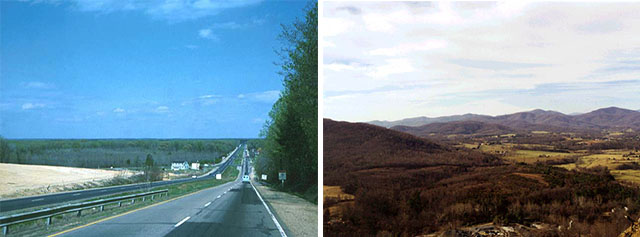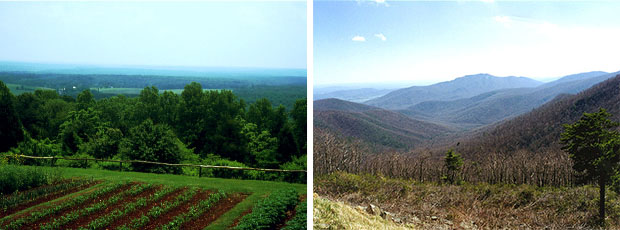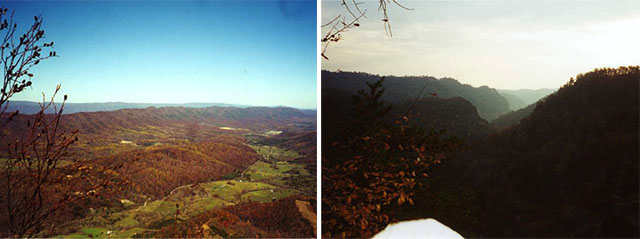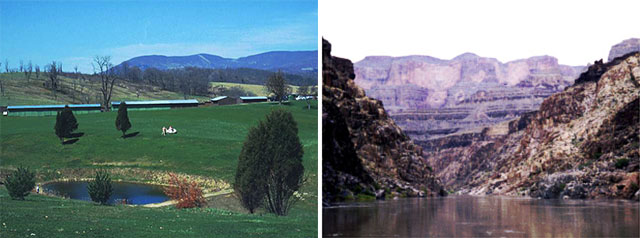
Introduction to Physiography, Part 1
• Physiography refers to the landforms present in an area; basically the same meaning as geomorphology.
• Physiographic province means a region (or area) with similar landforms that are distinctly different from the landforms in adjacent areas. Virginia has 5 physiographic provinces: Coastal Plain, Piedmont (including the Mesozoic Basins), Blue Ridge, Valley and Ridge, and Applalachian Plateaus.
 Contrast between landforms of the Coastal Plain and Piedmont provinces. Left photograph shows the generally flat Coastal Plain province. The right photograph shows the rolling foothills of the Piedmont.
(Left photography by Robert Whisonant, right photography by Stan Johnson)
Contrast between landforms of the Coastal Plain and Piedmont provinces. Left photograph shows the generally flat Coastal Plain province. The right photograph shows the rolling foothills of the Piedmont.
(Left photography by Robert Whisonant, right photography by Stan Johnson)
 Contrast between landforms of the Piedmont and Blue Ridge provinces. Left photograph shows the typical, low-relief, gently rolling hills and valleys of the Piedmont as they are seen from Monticello near Charlottesville. The right photograph shows the high relief and steep slopes typical of the Blue Ridge as they are seen from the Skyline Drive. (Left photograph by Robert Whisonant right photograph by Stan Johnson)
Contrast between landforms of the Piedmont and Blue Ridge provinces. Left photograph shows the typical, low-relief, gently rolling hills and valleys of the Piedmont as they are seen from Monticello near Charlottesville. The right photograph shows the high relief and steep slopes typical of the Blue Ridge as they are seen from the Skyline Drive. (Left photograph by Robert Whisonant right photograph by Stan Johnson)
 Contrast between landforms of the Valley and Ridge and Appalachian Plateaus provinces. Left photograph shows the linear ridges of the Valley and Ridge from McAfees Knob near Roanoke. Right photograph shows the deep, narrow valleys and steep slopes of the Appalachian Plateaus at Breaks Interstate Park in southwestern Virginia. (Photographs by Phyllis Newbill)
Contrast between landforms of the Valley and Ridge and Appalachian Plateaus provinces. Left photograph shows the linear ridges of the Valley and Ridge from McAfees Knob near Roanoke. Right photograph shows the deep, narrow valleys and steep slopes of the Appalachian Plateaus at Breaks Interstate Park in southwestern Virginia. (Photographs by Phyllis Newbill)
• Physiography is controlled by two factors:
• geology - kinds of rocks and geologic structures
• climate - precipitation and temperature
 Effects of climate on landforms. Limestone forms a valley in Virginia’s Giles County (left) where abundant precipitation dissolves the limestone. Limestone is much more resistant to erosion in dry climates and forms the distant ridge top in the Grand Canyon photograph (right). (Photographs by Robert Whisonant)
Effects of climate on landforms. Limestone forms a valley in Virginia’s Giles County (left) where abundant precipitation dissolves the limestone. Limestone is much more resistant to erosion in dry climates and forms the distant ridge top in the Grand Canyon photograph (right). (Photographs by Robert Whisonant)
Continued on next page